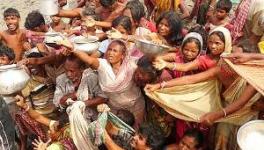India Braces for Prolonged and Severe Heat Waves Amid Climate Change and La Niña

Students shield themselves from the heat with a scarf on a hot summer afternoon in Meerut, UP. Image Courtesy: PTI
Summer has well and truly set in all over India. Monthly average temperatures in February have been the hottest since 1901. Temperatures were unusually high in western India in parts of Maharashtra and Konkan, and areas in Rajasthan recording as much as 7 C (degrees Celsius) higher than normal. Despite some freakish spells of untimely rains and hail in parts of the country, especially in western and northern India, due to multiple western disturbances, the Indian Meteorological Department (IMD) and other weather monitoring agencies are predicting serious heat waves in the three-month period till end-May, and also a below-normal monsoon. Government spokespersons have rushed to reassure the public that impacts would be minimal, for instance, that total rainfall would be within the range of normal variations and foodgrain production too would be near normal.
Last year too, the month of March was the hottest in a hundred years, and the country went through searing heat waves during April-May. This prolonged and early heat wave led to a drop in wheat production, with the government curbing the export of wheat, despite high international demand due to the war in Ukraine and the drop in wheat supplies from there. Monsoon rainfall last year too was in deficit in many parts of the country. We shall deal with the effects of these weather patterns later, but for now, let us focus on the weather itself.
It is clear that India has been witnessing unusually hot summers over the past several years with several bouts of heat waves, often quite extreme. It is also clear that this increasing frequency and severity of heat waves are not mere anomalies but evidence of a sustained transformation in a weather pattern caused by climate change.
So, let us understand heat waves in India, especially in the context of climate change, and unpack how climate change manifests as a global and regional phenomenon, with effects on the weather, monsoons, and so on.
HEAT WAVES
Weather records in India indicate that summer seems to be coming earlier in India, with average daytime temperatures as much as 3.4 C (degrees Celsius) above the normal. The number of states affected by heat waves since 2015 has more than doubled by 2020 to 23 states.
Heat waves may be divided into two broad categories, the first or “background” being usually occurring periods of high temperatures, and the second being “anomalies” or variations over and above background highs. The way India defines heat waves downplays their severity and increasing frequency. India declares heat waves in terms of absolute measures of temperatures in the plains or hills etc, rather than in relation to recent records. So lower temperatures, and fewer days with unusually high temperatures, are counted as “heat waves.” In fact, average temperatures have been rising over the years due to climate change, with surface temperatures now about 1.5C higher than, say, a hundred years ago. Weather patterns favourable for heatwave conditions such as periods of high pressure, sunny days, and low winds over north and north-west India are getting more frequent. Hotter heat waves lasting over longer periods are more dangerous and lead to higher fatalities apart from other impacts.
The year 2022 saw all the above factors, causing severe heat waves in India and Pakistan. With that in mind, the continuation of certain weather patterns has prompted both the IMD and the World Meteorological Organisation (WMO) to predict an enhanced probability of heat waves over most of India between February and May. A recent attribution study (i.e. the extent to which a phenomenon can be said to have been caused by climate change) has said that the probability of heat waves as of 2022 has increased by over 30 times due to climate change.
Another strong factor contributing to the heat wave prediction is the persistence of La Niňa (pronounced Neenya) conditions. This needs explanation.
El Niňo (pronounced Neenyo) and La Niňa (female counterpart) are natural climate phenomena occurring across the tropical Pacific Ocean, the former characterised by warm or increased sea surface temperatures, and the latter marked by ocean temperatures colder than usual. Together these are part of the El Nino Southern Oscillation (ENSO), with a few years being in a neutral state and then oscillating between the two conditions. These conditions influence weather conditions all over the world. In El Nino, westward blowing trade winds weaken, and surface waters flow eastwards towards South America, warming the region for six months. Under La Nina conditions, East Africa and West Asia witness dry and hot conditions influencing the sub-continent as well, with the possibility of excess rainfall and floods.
This year, WMO has predicted that La Nina which has prevailed since September 2020 is slated to continue through the summer of 2023, and withdraw only thereafter. Since 2020, La Nina has raised temperatures, affected rainfall patterns and worsened droughts and floods in different regions. This has been called the “triple-dip” La Nina, the first time since 1950 that La Nina has prevailed for three years. Meteorological experts have warned that the summer of 2023 is a disaster in the making, with severe heat waves due to weak western disturbances and the prevailing La Nina. WMO also cautioned that El Nino is expected to set in during July-August 2023, bringing with it even warmer conditions and a weak monsoon as witnessed in 2009, 14, 15 and 2018.
IMPACT
Prolonged and severe heat waves in India are expected to have wide-ranging impacts in India ranging from fatalities and hospitalisations especially among infants, the elderly and poorer populations living in crowded localities in poorly-ventilated dwellings, to low productivity, loss of education and economic losses.
India has the higher background or normal temperatures of over 40C, with only the Sahara and areas in West Asia having temperatures of that order, but with less dense populations and drier conditions, whereas India has higher humidity making living conditions more difficult. Experts point out, therefore, that what are called “wet-bulb temperatures” (measured by thermometers wrapped in wet cloth) are more important than the usual “dry bulb” temperatures that are reported in media weather reports. Whereas the usual dry bulb records the effect of temperature under the shade, wet bulb temperatures show the effects on the human body of ambient temperature, humidity, solar rays, wind etc and reflect efforts of the human body to counter heat by sweating. When humidity is high, cooling by sweating becomes less efficient and therefore the effect of high temperatures becomes more difficult to tolerate.
While it is generally believed that 35C wet-bulb temperature is the limit of human survivability, recent studies have suggested that 31.5C may be more realistic. At present, India already records an average of 32C. However, if one adds a few degrees for extreme heat waves, and additional heat stress due to the urban heat island (UHI) effect in crowded, concretised cities, wet-bulb temperatures would easily cross 35C. A recent World Bank report has said that India may well be the first country where temperatures may cross this survivability level.
Extended extreme heat waves have other effects too, of course. Heat waves dry the soil, with impacts on crop production and also increase the possibility and extent of flooding due to poor ability to absorb rainfall which runs off. The onset of monsoons can also be delayed by as much as a month. It also impacts energy production by lowering hydro-power production and increasing demand for fossil-fuel electricity. In anticipation of the probable heat wave this summer, the government is understood to have already called for greater utilisation of imported coal to ease pressure on domestic supplies.
Wheat production is also expected to be affected, as it was last year, although total production was not too badly affected due to increase in the area under cultivation.
Urgent action is also required in cities to neutralise the UHI effect by creating more open green spaces, shady areas and water bodies, apart from reducing the use of air conditioners through energy-efficient buildings and other measures.
Unfortunately, India is ill-prepared on all these fronts.
Get the latest reports & analysis with people's perspective on Protests, movements & deep analytical videos, discussions of the current affairs in your Telegram app. Subscribe to NewsClick's Telegram channel & get Real-Time updates on stories, as they get published on our website.
























